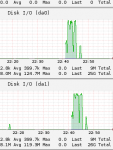sfcredfox
Patron
- Joined
- Aug 26, 2014
- Messages
- 340
Greetings,
I've been doing basic performance testing on some new acquired 6G SAS drives, and I'm not sure I understand my results.
This results in reporting a read speed of around 135MBps, not as high as most 3.5" 7200RPM SATA drives, but tolerable for slight seek time performance increase of SAS.
This results in reporting write speeds of 18MBps, yeah...18! Hmm...Terrible...
Hardware for this test is same signature system, but added an HP D2700 6G SAS enclosure 8088 connected to a 6G LSI 9205-8e (HP H221 HBA). I takes up to 25 2.5" disks.
I checked a few things out, thinking maybe the controller or new disk enclosure (HP D2700) sucked. I threw a consumer grade SSD in one of the slots and read ~450MBps and got ~250MBps write speeds. So I can see that the controller and enclosure don't seem to be jacked, but who knows.
Next I'm thinking, my old 3G SAS drives totally suck (read ~80MBps and write ~30MBps) so why shouldn't these? But these disks are 6G, and read much faster, so I'm a little puzzled why they perform worse on a DD write test, so maybe I'm the one screwing this up? Doing a wrong/stupid test?
I went ahead and threw two of these disks into a mirror to test writing in the pool, it oddly shows better performance.
This was ran from inside a dataset called test, and yes, both the dataset and the pool had compression turned off.
This time the result was ~250MBps write. That doesn't make a lot of sense to me, but that's why I'm asking this question, I must not understand what's going on and maybe I'm totally doing something wrong.
I included a snip from the performance graph which seems to show each drive writing at about ~150MBps. I guess I can't understand why dd results in only 18, but this seems to result in 150.
Thanks in advance
-Supporting Info Below-
The drive shows SPL-3 now that I combined it with a SATA disk during testing, but no changes in speeds have been seen between before and after (when there were no SATA drives present) It originally showed 600MBps (6G), I checked that it was properly detecting the speeds.
I've been doing basic performance testing on some new acquired 6G SAS drives, and I'm not sure I understand my results.
Code:
DD if=/dev/da0 of=/dev/null bs=1M
This results in reporting a read speed of around 135MBps, not as high as most 3.5" 7200RPM SATA drives, but tolerable for slight seek time performance increase of SAS.
Code:
DD if=/dev/zero of=/dev/da0 bs=1M count=15000
This results in reporting write speeds of 18MBps, yeah...18! Hmm...Terrible...
Hardware for this test is same signature system, but added an HP D2700 6G SAS enclosure 8088 connected to a 6G LSI 9205-8e (HP H221 HBA). I takes up to 25 2.5" disks.
I checked a few things out, thinking maybe the controller or new disk enclosure (HP D2700) sucked. I threw a consumer grade SSD in one of the slots and read ~450MBps and got ~250MBps write speeds. So I can see that the controller and enclosure don't seem to be jacked, but who knows.
Next I'm thinking, my old 3G SAS drives totally suck (read ~80MBps and write ~30MBps) so why shouldn't these? But these disks are 6G, and read much faster, so I'm a little puzzled why they perform worse on a DD write test, so maybe I'm the one screwing this up? Doing a wrong/stupid test?
I went ahead and threw two of these disks into a mirror to test writing in the pool, it oddly shows better performance.
Code:
dd if=/dev/zero of=testfile bs=1M count=15000
This was ran from inside a dataset called test, and yes, both the dataset and the pool had compression turned off.
This time the result was ~250MBps write. That doesn't make a lot of sense to me, but that's why I'm asking this question, I must not understand what's going on and maybe I'm totally doing something wrong.
I included a snip from the performance graph which seems to show each drive writing at about ~150MBps. I guess I can't understand why dd results in only 18, but this seems to result in 150.
Thanks in advance
-Supporting Info Below-
Code:
[root@Carmel-SANG2] /mnt/Tier1-Group2/Test# zpool status Tier1-Group2
pool: Tier1-Group2
state: ONLINE
scan: none requested
config:
NAME STATE READ WRITE CKSUM
Tier1-Group2 ONLINE 0 0 0
mirror-0 ONLINE 0 0 0
gptid/318af5d4-52ac-11e5-8a24-0025902b18fa ONLINE 0 0 0
gptid/3228acb4-52ac-11e5-8a24-0025902b18fa ONLINE 0 0 0
errors: No known data errors
Code:
[root@Carmel-SANG2] /mnt/Tier1-Group2/Test# zfs get compression Tier1-Group2 NAME PROPERTY VALUE SOURCE Tier1-Group2 compression off local
Code:
[root@Carmel-SANG2] /mnt/Tier1-Group2/Test# smartctl -a /dev/da0 smartctl 6.3 2014-07-26 r3976 [FreeBSD 9.3-RELEASE-p16 amd64] (local build) Copyright (C) 2002-14, Bruce Allen, Christian Franke, www.smartmontools.org === START OF INFORMATION SECTION === Vendor: HP Product: EG0300FAWHV Revision: HPDE User Capacity: 300,000,000,000 bytes [300 GB] Logical block size: 512 bytes Rotation Rate: 10000 rpm Form Factor: 2.5 inches Logical Unit id: 0x5000c50043d00f43 Serial number: 6SE538AQ0000B214B9K0 Device type: disk Transport protocol: SAS (SPL-3) Local Time is: Thu Sep 3 23:09:58 2015 EDT SMART support is: Available - device has SMART capability. SMART support is: Enabled Temperature Warning: Enabled === START OF READ SMART DATA SECTION === SMART Health Status: OK
The drive shows SPL-3 now that I combined it with a SATA disk during testing, but no changes in speeds have been seen between before and after (when there were no SATA drives present) It originally showed 600MBps (6G), I checked that it was properly detecting the speeds.

